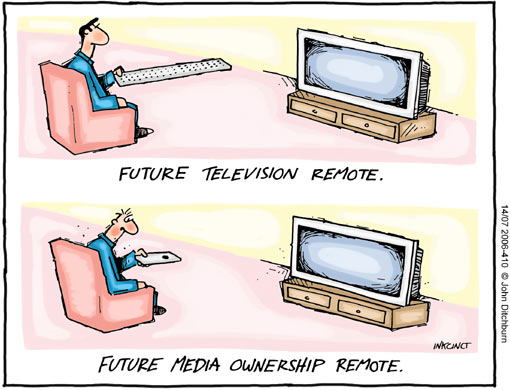Found this cute advertising video for Guardian, about how they are getting the “whole picture”. Also relates well to my degree.
Category Archives: bcm 110
Not So Pretty Anymore
What can make you feel shocked, angry, violated, disgusted and amused in 7 weeks? – why, the media of course! After engaging in the debates over the last 7 weeks, I have felt all these things as we are asked to not just skim the surface anymore, but delve into the deep, dark, somewhat hidden crevices of the media.
I walked into my first lecture – and most lectures after that – thinking that I had a rough idea of what the media entailed and the scandals and consequences that go with being in media – oh how wrong I was! I realised that I was digesting media and believing what I heard and saw because they were journalists reporting for a respected news program or in a prestigious newspaper. I was not watching/reading the news questioning the authenticity or bias of the story – I was not giving it an in-depth look. I now however, question everything.
Whilst I tend to be a fence-sitter on most issues, this topic of ‘Media Mythbusting’ has made me take a stance and enter into the scary side of choosing a side in which to defend. The one issue that enabled me to finally jump down, was the problem with the media effects model (read post here). I refuse to see the point that it is the media’s fault for turning humans into hideous, barbaric monsters – the media is simply a scapegoat. As the weeks and lectures went by, I suddenly gained a voice and again ranted and raved at the issue of why does it matter who controls the media and was quite shocked at just how many people Rupert Murdoch’s media reaches – 3/4 of the world’s population to be exact.
Through the in-depth study of the media, I have come to realise that one must look past the glossy, shiny covers to reveal the ugly inner workings of the media to fully understand what true media is.
The Never Ending Debate
Alan Mckee says that the public sphere is for “human beings [to] come together to exchange ideas and information and feelings about what matters to them“. While the metaphorical sphere has taken many forms over the years, the integral idea remains the same – building and encouraging discussion and debate over current issues. The ongoing debate of media and body image is one that is unlikely to disappear. However, when the Dove Self-Esteem Campaign disseminated, it sparked global attention and infiltrated many social spheres.
This campaign ticks all the right boxes regarding the concerns that popular media has – emotional, relationships and personal problems just to name a few. However, it does leave a few unchecked – including:
- the only power we have is in the realm of our own lives
- the only issues that are presented in popular media are those closely related to people/businesses in power.
I say that these are left unchecked as print media wanted to silence this particular debate as it was intentionally directed at them and they rightfully felt threatened by the growing popularity of citizens wanting realistic figures in media and less sexualised women in ads. This shows that public spheres are somewhat powerful when it comes to propagating current issues. Furthermore, this campaign highlights the fact that we do not only have power in our own lives but we have a voice that can potentially gain strength in other individual’s lives. This notion of touching other’s lives was because of public spheres and the discussions that continued outside these circles.
However, there was quite a lot of criticism when it was first released. Chicago CBS news reporter, Bill Zwecker said,”we are facing a huge obesity problem in this country, we don’t need to encourage anyone — women or men– to think it’s okay to be out of shape.” I think he missed the point or was not attending his local public sphere.
Note: This is another amazing Dove Ad written and directed again by the wonderful Tim Piper:-
New Edition: Spoonfed Beliefs – Out Thursday!
From a young age, your parents decide on every little thing that you do so as to develop your understanding, beliefs and morals. So how come we let money-hungry media giants decide for us when we are adults?
Simply, because we do not have a choice anymore. Media corporations such as NewsCorp and Fairfax are deciding what we digest over our Sunday cup of coffee. Some people may brush this off but as Malcolm Fraser states in his article, that if we continue down this road of monopolizing media,”Australia will be effectively without independent print media” or potentially any type of media.
I have been raised to not just believe what you see, hear or read for you should always question it and come to your own conclusions. As mentioned many times before, I borderline Gen Y and Gen Z therefore making me lazy and addicted to social media – but is this necessarily a bad thing when it comes to media ownership? Personally, I think it is, for younger generations are more likely to believe what they are presented with due to laziness and potentially their upbringing. If you are not constantly questioning what you are presented with, how can you form your own arguments and ideas about what is ‘right’ and ‘wrong’ when it comes to media?
Conversely, I believe that older generations are more skeptical of what the media produces as ‘old’ people are skeptical of most things – and this is partially due to their upbringing and beliefs that the media is a very “powerful instrument for propaganda” (Fraser). And this is where the issue of sly political messages are sometimes evident in media – print especially.
The issue of media ownership will be ever-present as we move into monopolised ownership. This is particularly unnerving as how are younger generations supposed to unbiasedly choose who to vote for, who to believe or even what to believe, if the constant onslaught of media is one-sided because the media moguls are breathing down the editor’s neck ? This is an age that I hope not to witness.
Controversial Ad Response
This was aired on the Channel 7 morning news program Sunrise after there was much debate about which states this ad was allowed to air and also the outcry about the young boy’s mental state after filming this ad.
If a picture is worth a thousand words, how much is controversial ad?
After countless years and millions spent on “Quit Smoking” campaigns, has this ad taken it too far? Or, have we finally found the right way to address this issue as expressed in this 2009 ad?
As this advertisement began to disseminate globally, public outcry grew rapidly. The obvious denotations of this ad are a young, innocent boy, losing sight of his mother at a busy train station and the horrific sense of panic that arises. However, the study of this text’s connotations and semiotics, reveals the once ambiguous divide of a nation’s cultural ideologies as the reality of this young boy’s predicament dawns on the audience.
My father smoked for 20+ years before going ‘cold turkey’ after my mother announced her pregnancy. He did this so he could be around to watch myself and my sister grow up and lead happy, healthy lives. When this ad debut in 2009, my father would always walk out of the room as he could not watch this young boy’s pain for it could just as easily been his children’s reality.
This ad signified – and broke down the ideologies surrounding smoking -to the myriad of people who viewed it, that dying from smoking does not have to be when you are old and grey, leaving behind adult children. And for this reason, it mortified many people and encouraged them to seek help and quit.
Post-2009 most advertisements for “Quit Smoking” have become more graphic yet less personalised. We can simply turn a blind eye to the grotesque images of mouth cancer and the wheezing of lung cancer. It is estimated in these statistics that by 2030, one in six people will die of lung cancer if trends continue. So where are we going wrong? Education about the affects of smoking has increased significantly in the past decade or so. So, does the answer lie in this type of heart-wrenching advertising?
Pass the blame to the left hand side
When most people are asked, “does TV make you fat?” the majority will scoff at this idea – and I was no exception. It seems utterly absurd that by sitting in front of the televsion it somehow magically expands your waistline. This is the theory of causality – one thing (in this instance, televsion) causes another thing to occur (people becoming fat). Whilst most people can accept this theory, others – such as David Gauntlett – digress:
“the connections between people’s consumption of the mass media and their subsequent behaviour have remained persistently elusive..”
Gauntlett later states:“The’media effects’ approach..comes at the problem backwards, by starting with the media and then trying to lasso connections from there on to social beings, rather than the other way around.” This grahic of obesity in America supports his statement that the media is constantly being blamed when in actual fact 60% of people who were surveyed said it was too much in-home entertainment that led to their obesity and 84% saying that it was eating too much fast food. This leads onto the question of does watching violent media, make you a violent person and do violent things?
The horrific case of James Bulger is a true testament to Gauntlett’s belief of the backwards approach of the media effects model. In 1993, a 2 year old boy was abducted, brutally beaten and subsequently killed. His killers were two ten year old boys. In court, the judge stated, “violent films, possibly Child’s Play 3” had “striking similarities to the manner of the attack on James Bulger…” The media went into a frenzy, blaming violent videos and games saying that it led young children to re-enact scenarios that they had seen in various forms of media. However, further investigation into the lives of the two young killers exposed dysfunctional families where violence and neglect were common.
So, I leave you with this: is it really the media’s fault, or are we simply passing the blame to the left hand side?

